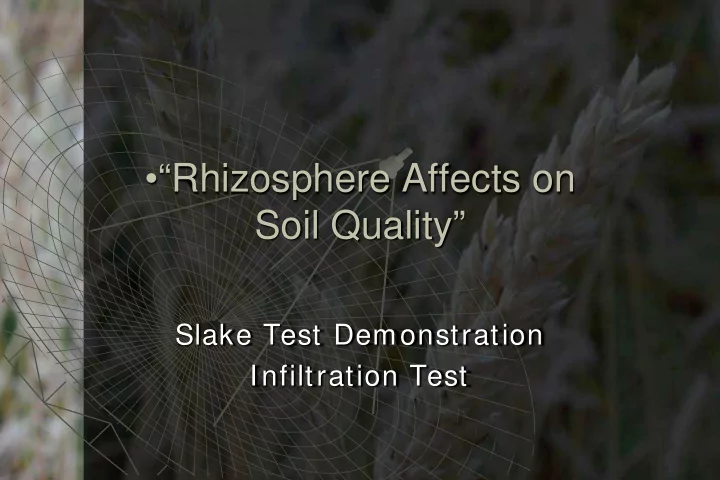

•“Rhizosphere Affects on Soil Quality” Slake Test Demonstration Infiltration Test
George D. Derringer Resource Soil Scientist Southwest Ohio 937-836-5428 Ext. 107
This is the same soil- What happened? Both soils started with the same Inherent soil Properties soil : Dynamic properties depend both on land management and inherent properties of the soil: •climate (precipitation and temperature) • organic matter, 62.8% loss of •topography (shape of the land) • soil structure, SOM after 17 •biota (native vegetation, animals, and microbes) • infiltration rate, yr intensive •parent material (geologic and organic precursors to the soil) • bulk density, tillage •time (time that parent material is subject to soil formation processes) • and water and nutrient holding capacity. 62.8% loss of SOM after 17 yr intensive 20 cm layer tillage Grassland Soils Forest CT 17 yr- Soybean monoculture SOM = SOM = 4.3 % 1.6 %
Mimic Nature: The Supreme Farmer. Natural soil ecosystems: Have a diverse living growing root in the soil at all times- generally nutrients don’t leak Man’s agroecosystems- leak nutrients: 2/ 3 of year the soil is bare in the corn belt!
What holds the Porosphere together? Maintenance mode Repair mode No-till Grass systems Conventional tilled From ATTRA - Soil Quality Publication
OHIO (2010) BIRD’S EYE VIEW Productive factory workers
Decomposition active zone Aggregation active zone Zone of aggregation in layers This enrichment of the surface layer with SOM maintains soil quality by enhancing aggregation and facilitating aeration (Doran and Parking, 1994; Franzluebbers, 2007).
Hierarchical Approach to Understanding Soil Function Detritusphere Drilosphere Porosphere Aggregtusphere Rhizosphere
Rhizosphere The number of bacteria negative gram in the rhizosphere is from 5 to 2000 times larger than in the regular soil.
Managing for microbial habitat in the soil Less Disturbance of the soil. More diversity in what is grown in the soil. Living roots in the soil as much as possible. Keep the soil covered with crops and their residues. These are the ‘keys to the kingdom’ of improving soil quality and sustainable agriculture because they focus on soil biology and soil ecology; what really runs the soil and all that it does.
IF YOU BUILD IT THEY WILL COME First you have to create a habitat for all the organisms that live in the soil No Tillage will be the best, and then conservation or minimum tillage. Anytime you can have a forage or pasture phase in the rotation you will be creating and maintaining an undisturbed habitat. Even what appears to be a derelict soil there will be a number of microorganisms that are in resting stages waiting for the right condition: one earthworm per square metre can become 10 or more in one season given a good food source and the right conditions.
The Detritusphere: . Protects the aggratusphere and the poroshpere from the sun, wind and rain • Lowers temperture and evaporation • Provides habitat and food for soil organisms • Enhances biogeochemical nutrient cycling • Builds soil structure and nutrient reserves • 20 percent of total carbon energy for soil
FOOD WEBS Soil food webs are mainly based on three primary carbon (C) sources: root exudates, litter or residues, and soil organic matter (SOM). These C sources vary in their availability and accessibility to soil organisms, and can thus, increase the C flow and biodiversity within the food web.
SOIL IS A LIVING, BREATHING, ENERGIZED COMMUNITY OF ORGANISMS
Arthropods
Aboveground diversity is a mirror for belowground diversity
HOW COVER CROPS WORK TO INCREASE BIODIVERSITY Increase the quality and quantity of soil organic matter Remember it is not just about the above ground residues, roots are the most available source of organic matter in the soil. The rhizosphere (rooting zone) is the most biologically active part of the soil Roots leak carbohydrates, amino acids, organic acids, and a number of other complex compounds that feed the microorganisms in the rhizosphere Each plant species leaks its own unique signature of compounds into the rhizosphere. The more diverse the plant community above ground the more diverse the community below ground A greater diversity of soil services
Root and Mycorrhizal Fungi Association: Enlarged Soil aggregates Glomalin and hypae Dr. Kris Nichols, Microbiologist, ARS, Mandan, ND
vasicular-arbuscular mycorrhizal (VAM) fungi Rhizosphere Dennis Froemke ND Area Range Specialist
Soil Engineers: Earthworms Subsoil macropores - Model of earthworm burrow systems - 75 ind/m 2 - 30% endogeic ( ∅ 2-3 mm) - 70% anecic ( ∅ 6 mm) - ∅ core 212 cm 1 m 1 m Bastardie, Capowiez et al. Biol Fertil Soils (2002) 36:161–169
Drilosphere: Zone of earthworm influence •Redistributes plant litter “Carbon” throughout the soil the profile • Soils are enriched with N,P , and humified organic matter •Increase water infiltration •Provide a bio pore for plant roots •Homogenize soil surface •Increase bio-diversity in soils M.H. Beare, D.C. Colem an, D.A. Crossley Jr., P.F. Hendrix and E.P. Odum ( 1 9 9 5 )
EARTHWORMS & OTHER SOIL ANIMALS LIKE MUSTARD AND CANOLA Photo by Francis Yeatman
BI ODI VERSITY Flexibility Resilience Resistance The ultimate insurance!
WORKING WITH ROOTS Each Plant Species has different: Root Exudates Root biomass and architecture Architecture affects the: Distribution and number of organisms Soil stability Amount of habitat Amount of exudates
Rooting depths Creating a root canopy Deep Moderate Shallow Alfalfa Barley Pea Safflower Canola Flax Sunflower Wheat Lentil Buckwheat
Tillage disrupts Drilo- Poro-Detritus-Rhizo-and the Aggregtus-sphere CO 2 CO 2 CO 2 PHYSI CAL DI STURBANCE: Tillage induces the native bacteria to Loss of SOM as CO 2 consum e soil carbon; byproduct is C0 2 .
Aboveground diversity is a mirror for belowground diversity
Recommend
More recommend